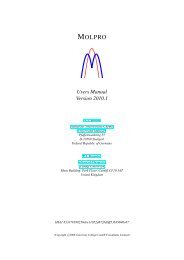Carbon−Carbon Coupling Reactions Catalyzed by Heterogeneous ...
Carbon−Carbon Coupling Reactions Catalyzed by Heterogeneous ...
Carbon−Carbon Coupling Reactions Catalyzed by Heterogeneous ...
You also want an ePaper? Increase the reach of your titles
YUMPU automatically turns print PDFs into web optimized ePapers that Google loves.
<strong>Heterogeneous</strong> Pd <strong>Catalyzed</strong> C−C <strong>Coupling</strong> <strong>Reactions</strong> Chemical Reviews, 2007, Vol. 107, No. 1 145<br />
Scheme 14. Synthesis of Carbene-Pd Complexes Fixed to<br />
Modified SiO2<br />
Table 23. Suzuki <strong>Reactions</strong> of Chloroarenes with Phenylboronic<br />
Acid a<br />
R catalyst yieldb (%)<br />
Ac Pd(OAc)2/53<br />
Pd complex 55<br />
90<br />
86c OCH3 Pd(OAc)2/53<br />
Pd complex 55<br />
93<br />
88c CH3 Pd(OAc)2/53<br />
Pd complex 55<br />
91<br />
85c CHO Pd(OAc)2/53<br />
Pd complex 55<br />
97<br />
90c a Reaction conditions: 1.0 mmol of chloride, 1.5 mmol of PhB(OH)2,<br />
3 mL of dioxane. b Isolated yield. c Fourth run.<br />
ing was not found, and the same catalyst sample was reused<br />
eight times without decreased activity (Table 24). 124<br />
Scheme 15. Preparation of SiO2-OC-Pd Catalyst 60<br />
Table 24. SiO2-OC-Pd-<strong>Catalyzed</strong> Suzuki <strong>Reactions</strong> in Aqueous<br />
Media<br />
conditions X t (h) conv (%)<br />
water/TBAB Br 1 62<br />
water Br 99<br />
water Cl 0.25 91<br />
water a Cl 2 99<br />
water/dioxane (3:2) Cl 0.25 55 b<br />
a Catalyst was reused eight times. b Biphenyl was detected as<br />
<strong>by</strong>product.<br />
Silica-supported imidazole-palladacycles SiO2-IM-Pd-H<br />
62 and SiO2-IM-Pd-Me 63 (Figure 2) exhibited excellent<br />
catalytic activity, recyclability, and stability in Suzuki-<br />
Miyaura coupling of aryl bromides and phenylboronic acid<br />
(Table 25). 125,126 The catalysts had very low loading of<br />
palladium and were considered to be completely heterogeneous<br />
under the reaction conditions.<br />
Figure 2. SiO2-IM-Pd-H, 62, and SiO2-IM-Pd-Me, 63.<br />
Table 25. Suzuki <strong>Reactions</strong> <strong>Catalyzed</strong> <strong>by</strong> Modified<br />
SiO2-Supported Pd Complexes<br />
R catalyst t (min) yielda (%)<br />
H 62 (1.2 mol %) 180 95<br />
CN 62 (1.2 mol %) 120 92<br />
Cl 62 (1.2 mol %) 180 88<br />
OMe 62 (1.2 mol %) 360 79<br />
CH2Br 62 (1.2 mol %) 360 60<br />
H 63 (0.4 mol %) 90 100<br />
OMe 63 (0.4 mol %) 120 92<br />
CN 63 (0.4 mol %) 60 97<br />
PhCO 63 (0.4 mol %) 90 95<br />
OH 63 (0.4 mol %) 90 85<br />
a GC yield.<br />
The imine-based palladacyclic silico-supported catalysts<br />
65 and 66 (Figure 3) were found to be less active in Suzuki<br />
reactions of aryl bromides with phenylboronic acid than their<br />
homogeneous counterparts. These catalysts also exhibited<br />
poor recyclability probably because of the instability of the<br />
complex liberating zero-valent Pd species in the solution <strong>by</strong><br />
reductive elimination. 127<br />
Figure 3. Imine-based palladacyclic catalysts 65 and 66.<br />
2.5. Pd on Clays and Other Inorganic Materials<br />
Sepiolite clay supported Pd (Pd(II)-sepiolite) could easily<br />
be obtained <strong>by</strong> treating the clay with aqueous [Pd(NH3)4]-<br />
Cl2 and drying under vacuum. It effectively catalyzed the<br />
Suzuki coupling of phenylboronic acid with aryl halides in<br />
DMF including less reactive electron-rich aryl bromides<br />
(Table 26). 128 The catalyst exhibited a remarkably high TON,<br />
and thus low amounts of catalyst were necessary (0.02 mol<br />
%).<br />
The unusually high reactivity of electron-rich bromoarenes<br />
in comparison with the commonly much more reactive<br />
electron-poor bromoarenes (entries 3-5 versus entries 6-7)<br />
suggests that the oxidative addition of aryl halide to the Pdcatalyst<br />
cannot be the rate-determining step in these cases.<br />
Shimizu et al. also applied Pd(II)-sepiolite to the Suzuki<br />
coupling of 4-bromophenol with phenylboronic acid or<br />
sodium tetraphenylborate in water at room temperature in<br />
air. 129 It provided higher yields than unsupported Pd(II) salts<br />
and some other supported-Pd catalysts (Scheme 16).












![Hetero [6+3] Cycloaddition of Fulvenes with N-Alkylidene Glycine ...](https://img.yumpu.com/35423358/1/190x245/hetero-6-3-cycloaddition-of-fulvenes-with-n-alkylidene-glycine-.jpg?quality=85)




